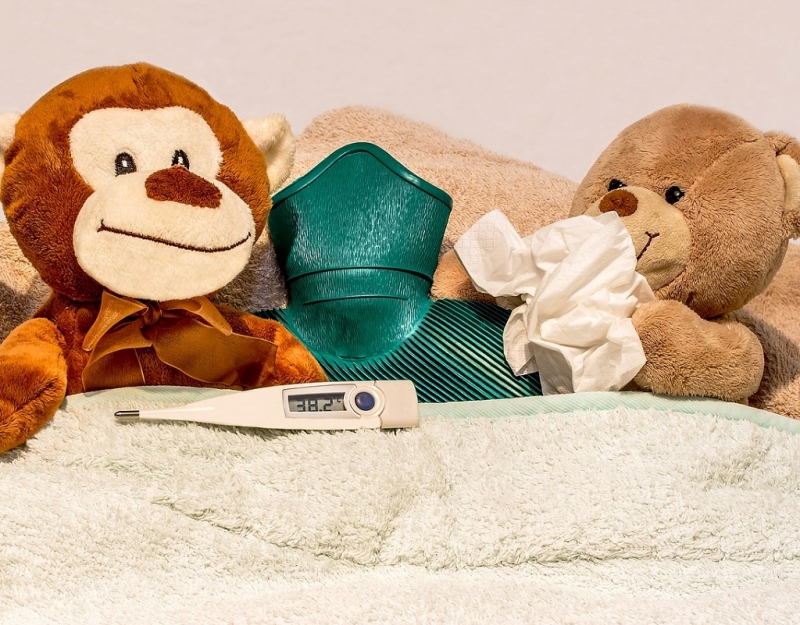If your child is sick and you call the doctor, he may ask you whether or not your child has a fever. The only way to accurately determine if your child has a fever and how high that fever is, is to take your child’s temperature.
There are two things you need to know to help your child’s doctor assess your child’s temperature:
- How to take your child’s temperature
- Where to take your child’s temperature
Knowing how to take your child’s temperature helps you get the most accurate reading possible, and telling your doctor where you took the temperature (e.g., under the arm, orally, rectally, in the ear, etc.), helps your doctor gauge how serious your child’s fever really is.
Several advances in digital technology have given parent’s new and easier ways to take their child’s temperature. Digital thermometers can be used under the arm (axillary temperature), in the ear (tympanic temperature), and in the mouth (oral temperature). Still, the most accurate way to take a child’s temperature, especially for very young children, is in the child’s bottom (rectal temperature).
Digital thermometers are generally considered safer to use than traditional mercury thermometers because mercury is a toxic substance. They are designed to beep after they sense that the registered temperature is not going to rise any further.
Taking a rectal temperature
Taking your child’s temperature in her bottom gives you the most accurate reading. Using a rectal mercury thermometer (the one with the rounded tip) or rectal digital thermometer, prepare the thermometer by covering it with a plastic probe cover designed for rectal use and dip it in a bit of white petroleum jelly to make it easier and more comfortable to insert.
With your child lying, belly down, across your lap or on a changing table, gently insert the thermometer into the anus about 1.25cm for very young children to 3cm for older children. You will need to stay with your child and hold the thermometer in place. Remove the thermometer after three to five minutes and read the result. Digital thermometers beep to let you know when to remove them. It is very important, when taking a rectal temperature, to use only a rectal mercury or digital thermometer. These thermometers are specially made with rounded tips to prevent damage to delicate rectal tissue.
Taking an underarm temperature
Taking a temperature under the arm is called an axillary temperature, and gives the least accurate reading. Under arm temperatures can be up to 0.5° to 1.2°C lower than actual body temperature. However, taking your child’s temperature under the arm is usually easier and faster than struggling to get an oral temperature from a wriggling and/or crying child.
To take your child’s axillary temperature, raise her arm and place the thermometer snuggly into her arm pit with the tip of the probe about mid pit. Lower her arm and hold it flat against her side until the digital thermometer beeps, or for three to five minutes for a mercury thermometer.
Taking an oral temperature
Taking an oral temperature is one of the best ways to get the most accurate reading. However, children under the age of four should have their temperatures taken rectally or under the arm because they may bite the thermometer.
Using a digital or mercury thermometer, place the thermometer tip directly under your child’s tongue. Have the child lower his tongue and close his mouth, but instruct him not to bite down on the thermometer. Wait until the digital thermometer beeps signaling it is done, or for three to five minutes for a mercury thermometer, remove the thermometer and read the result.
Taking your child’s temperature orally might not be possible if he is very congested, because he won’t be able to breathe with his mouth closed. If your child is very congested, try taking his temperature under his arm.
Taking a tympanic temperature
Tympanic temperatures can only be taken with specially designed ear thermometers. You cannot use a mercury thermometer or regular digital thermometer to take a tympanic temperature. They are not safe to insert into the ear and are not designed to correctly register a tympanic temperature.
Using an ear thermometer, gently tug on the ear to straighten the ear canal. Place the end of the ear probe into the ear canal. Once the digital ear thermometer beeps, it’s ready to read.
Don’t take your baby’s temperature with an ear thermometer. Ear thermometers are not designed for use in infants because their ear canals are so small. Ear thermometers only work properly if they are kept clean. Wax build-up on the thermometer can affect the reading, so be sure to clean the thermometer properly after each use or use a disposable probe cover.
What you need to know about taking your child’s temperature
- Tell your doctor where you took your child’s temperature; eg. ‘His temperature is 39°C under the arm’ or ‘Her temperature is 40°C orally”.
- Digital thermometers are considered safer than mercury thermometers and are reasonably priced.
- Clean your thermometer thoroughly after each use. Don’t use hot water on a mercury thermometer as it can cause the thermometer to burst.
- Never leave your child unattended while taking their temperature.
- If your child has been snuggled up in a warm bed or just taken a bath or shower this can affect the temperature reading. Allow 15 minutes and retake their temperature.
Written by Rebecca Stigall with editing by the Kidspot NZ team.
Read more:







I use a digital thermometer, but we always go under arm. I think it’s just easier for us, and it keeps it relatively clean for our germ-phobic eldest. I have heard that some digital thermometers can be inaccurate, but I think as long as you keep the batteries fresh, and you understand the range of normal for your child and that thermometer, then you should be okay.
I was given an older style underarm thermometer by a Nurse I used to work with. It takes a while to take the reading but works well and I trust it’s readings – as above it’s generally a little lower than the actual temperature. I’m just not sure how much I trust the instant one’s that take it in a second. Guess I’m just a bit old fashioned.